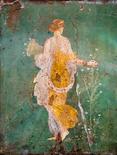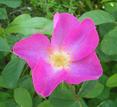What ancient Greek stories of humans transformed into plants can teach us about fragility and resilience
Published in News & Features
For me, gardening is the most joyful summer activity, when I can see my hard work rewarded with colorful blooms and lush greenery. Science explains this feeling by recognizing the deep bond between humans and plants. Being in a nurturing relationship with nature supports our physical and mental health.
At the same time, as a scholar of Greek mythology, I also see the close relationship between humans and plants reflected in ancient stories. In fact, Greek literature and poetry often represent human life as plant life.
Just like plant life, human life follows the course of the seasons. Our youth is brief and beautiful like the spring, followed by the full bloom of adulthood in summer and the maturity of middle age, which yields bounty and prosperity like the fall harvest. Finally, in the winter of our life, we wither and die, to be replaced by a new generation, as famously described in the Greek epic “The Iliad”: “Like the generations of leaves are those of men. The wind blows and one year’s leaves are scattered on the ground, but the trees bud and fresh leaves open when spring comes again.”
In this way, Greek mythology spells out that human life, with its beauty and its sufferings, is part of the broader cycle of nature and should be viewed on par with other living creatures, such as plants.
Spring flowers are brightly colored, but they only last a short time, so they reminded the Greeks of the beauty and promise of youth and the tragedy of young lives cut short.
For instance, Greek myths tell the story of Narcissus, a young hunter who was so beautiful that he fell in love with his own image reflected in a pool. He couldn’t tear himself away, so he eventually withered on that spot and gave his name to a pale white and yellow flower, the narcissus, which is called daffodil in English.
Similarly, after the beautiful Adonis, beloved of the goddess Aphrodite, died in a boar hunting accident, the goddess turned his blood into the red anemone flower, the “wind-flower” – Anemone coronoria – named for its fragile stem tossed in the wind.
The hyacinth recalls the beautiful boy Hyacinthus, who was killed while he trained with the discus. His lover, the god Apollo, grew a flower on the spot and inscribed the letters AI on it, representing the Greek exclamation for grief “Ia! Ia!” Other authors say it represents the beginning of Hyacinthus’ name in Greek – Ὑάκινθος.
Scholars believe that this flower is not the hyacinth commonly grown in our gardens – Hyacinthus orientalis. The exact species of the flower, however, is still debated because it is difficult to find a flower that looks like it has letters on it, as the ancient descriptions assert.
The beauty of young women was also associated with ephemeral spring flowers. Violets and roses appear with Aphrodite, the goddess of love, and in love poetry. The ancient rose, unlike our modern heavily hybridized cultivars, only bloomed briefly in the spring and thus was a fitting image for the fleeting beauty of youth.
Because flowers are associated with beauty and attractiveness, picking flowers in Greek mythology evokes a young woman’s discovery of sexuality. For instance, the beautiful Europa, a princess from the Eastern Mediterranean, was picking flowers when she was abducted by the god Zeus and transported across the sea to the island of Crete, where she gave birth to the mythical king Minos.
As classical scholar André Motte demonstrated, the discovery of sexuality was frequently formulated in terms of death, and flowery meadows were imagined to be a portal to the underworld. For instance, the beautiful young Persephone, daughter of Demeter, was picking a bouquet of lilies, narcissus and violets when she was abducted by Hades, the god of death.
While spring flowers represented sexual attraction, the fruit that comes in the summer and fall, to the Greeks, represented the consummation of sexuality. Thus, once Persephone was in the underworld, she accepted a pomegranate from Hades, which sealed her fate to remain in the underworld for a part of each year.
The pomegranate, whose bright red juice recalls blood, was often seen as a symbol of sexuality as well as early death in Greek art. Indeed, Persephone is symbolically dead while in the underworld, and her absence brings about winter on Earth.
Similar to pomegranates, apples are common as lover’s gifts and represent female fertility. Gaia, the Earth goddess, created the apple tree for Hera’s wedding, emphasizing the beauty and fertility of this divine bride, the goddess of marriage and queen of the Greek pantheon.
After the fruit of the harvest has been consumed and the fall has turned to winter, both plants and humans wither and die.
The Greeks imagined that plants were colorless in the underworld because white was the color of ghosts. The dead lived in meadows of asphodel, a grayish-white flower, and pale willows and white poplars also grew there. The god Hades created the white poplar in memory of the nymph Leuke, “the White One,” whom he loved before her untimely death.
In contrast, the dark cypress also represented the dead and was commonly grown on funerary monuments. The tree was named after Cyparissus, a boy who inadvertently killed his pet deer and mourned unceasingly, so much so that he was transformed into the tree that symbolized mourning.
However, some plants survive the winter and keep their green color, such as the laurel, myrtle and ivy, which were common in ancient Greek and Roman gardens. The ivy offered hope during the dreary season because it was sacred to Dionysus, a god of joy, wine and freedom who had returned from the dead. Ivy represented Dionysus’ power to spread happiness and the ability to free people from the bonds of everyday experiences.
Today, ivy is still seen as a symbol of eternal life and everlasting loyalty, and is featured both on funerary monuments and in bridal bouquets.
Why did the natural beauty of the plant world, for the Greeks, evoke so many sad stories?
As noted by classical scholar Alessandro Barchiesi, “Nature is in perennial flux, everything transforms, but metamorphosis tends to produce a new ‘state of nature’ that no longer changes.”
By acquiring a new form through metamorphosis, the people in these stories attain a stable life that resolves the misfortunes they have gone through. For instance, Cyparissus, mourning for his deer, finds a reprieve from his grief by becoming a cypress. At the same time, his story is not forgotten since it is memorialized in the very name of the cypress and its significance as a tree of mourning.
In this way, metamorphosis offers relief from painful experiences by integrating the sufferer into the eternal and stable cycle of nature, while commemorating the transformation through stories.
Greek mythology suggests that human sufferings, though painful, eventually come to an end because they are part of the broader and everlasting cycle of nature. Still today, these stories teach us to view our own grief and the painful experiences we go through in the broader context of the ever-changing, yet cyclical, natural world.
In this way, like the people in the Greek stories who are transformed into plants by intense grief, we too can find consolation in learning that grief itself changes over time, and most importantly, it changes who we are as people.
This article is republished from The Conversation, an independent nonprofit news site dedicated to sharing ideas from academic experts. If you found it interesting, you could subscribe to our weekly newsletter.
Read more:
Rosh Hashana and Yom Kippur are times for soul-searching, but not on your own – community has always been at the heart of the Jewish High Holidays
Amazonian psychedelic may ease severe depression, new study shows
Marie-Claire Beaulieu does not work for, consult, own shares in or receive funding from any company or organization that would benefit from this article, and has disclosed no relevant affiliations beyond their academic appointment.

















Comments